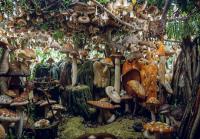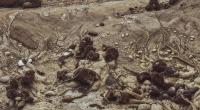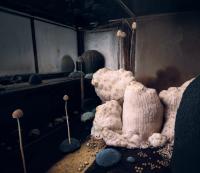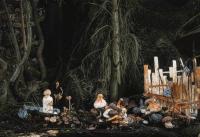Subscribe to the Newsletter
Your cart is empty
Shop nowAfter Wall
In 1993, Jeff Wall meticulously reworked Hokusai's famous woodblock print, spending over a year orchestrating actors and stitching together 50 photographs to create “A Sudden Gust of Wind (After Hokusai)”. Three decades later, AI image generators can create variations of Wall's composition in seconds. In my series “After Wall”, balanced arrangements of individuals are transformed into organic, fungal-like tableaux, signalling a revolutionary shift in how we can understand authorship, artistic production and artistic value in the current age of AI.
New technologies are transforming not just the speed of production but the complex nature of creative collaboration, inspiration and authenticity. Many of Wall's works pay homage to art historical references, synthesising material from cinema, literature and painting. I extend this chain of inspiration through AI technology, exploring how Wall's compositions can serve as creative prompts for AI image generation.
This process is far from automatic. Prompt-writing is an emerging aesthetic practice in its own right, situated somewhere between programming, poetics and visual composition. While the software renders images in seconds, creating effective prompts requires a nuanced understanding of how AI systems interpret language and codify images. For me, this is a slow, iterative dialogue that demands precision, experimentation and visual sensitivity. Rather than instructing the machine, I tune into its interpretive logic; making hundreds of small shifts in phrasing to yield dramatically different outcomes. Prompt-writing becomes an intuitive ritual, and resists automation; it relies on a felt understanding of how words bend, break and translate through the algorithm’s lens.
Using fungi as a metaphorical device, I draw parallels between natural collaborative ecologies and AI's capabilities. My visual language draws inspiration from my experiences touring around and walking in the Scottish landscape. I am interested in the natural world, particularly mycorrhizal networks, whose organic, networked forms replace Wall's carefully positioned human figures. The fungi, mould and spores I focus on resonate with themes of decay, regeneration, and transformation. Referencing these forest ecosystems linked through microscopic connections – what biologists call the “Wood Wide Web” – these images suggest a different kind of creative ecosystem, one where ideas flow, merge and transform across boundaries of human and machine intelligence. By recasting Wall's human-centric compositions with the proliferation of organic forms, these re-enactments move away from the concept of the sole creative genius, toward a more collaborative vision of creativity.
I am interested in how the concept of authorship constantly shifts as AI tools increasingly produce photorealistic images that draw from varied sources. Just as Wall's use of digital technology invites viewers to question the authenticity of meticulously constructed scenes, I am attempting to challenge the perception of what a photograph can become. AI-generated works compel us to rethink artistic labour, intent and the threshold of originality. Ultimately, like the fungal networks that enable trees to share resources and information, AI systems create pathways for artistic ideas to flow, merge and transform. Avoiding an anthropocentric point of view that privileges humans above all other natural and artificial beings and forms, I am in favour of a different cosmic order: a harmonious structure where individual vision and collective intelligence can coexist and inform one another.
Ben Millar Cole is part of Issue 17 by Guest Editor Torbjørn Rødland.
Check out his Artist Feature Computers Can’t Jump.













